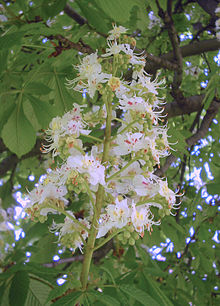What does Horse Chestnut mean?
Definitions for Horse Chestnut
horse chest·nut
This dictionary definitions page includes all the possible meanings, example usage and translations of the word Horse Chestnut.
Princeton's WordNet
horse chestnut, buckeye, Aesculus hippocastanumnoun
tree having palmate leaves and large clusters of white to red flowers followed by brown shiny inedible seeds
buckeye, horse chestnut, conkernoun
the inedible nutlike seed of the horse chestnut
Wikipedia
horse chestnut
The genus Aesculus ( or ), with species called buckeye and horse chestnut, comprises 13–19 species of flowering plants in the family Sapindaceae. They are trees and shrubs native to the temperate Northern Hemisphere, with six species native to North America and seven to 13 species native to Eurasia. Several hybrids occur. Aesculus exhibits a classical Arcto-Tertiary distribution.Mexican buckeye seedpods resemble the Aesculus seedpods, but belong to a different genus. Carl Linnaeus named the genus Aesculus after the Roman name for an edible acorn. Common names for these trees include "buckeye" and "horse chestnut", though they are not in the same order as the true chestnuts, Castanea in the Fagales. Some are also called white chestnut or red chestnut. In Britain, they are sometimes called conker trees because of their link with the game of conkers, played with the seeds, also called conkers.
ChatGPT
horse chestnut
The horse chestnut is a type of deciduous tree, scientifically known as Aesculus hippocastanum, native to southeastern Europe. It is known for its sturdy growth, reaching up to 25 meters in height, and its palmate leaves. Most recognizable are its large, round seeds, commonly known as conkers or horse chestnuts, contained within a spiky green outer shell. Despite their name, these are not true chestnuts and are not edible for humans, but can be eaten by horses and other livestock in small amounts. The tree is also known for its showy white flowers that bloom in the spring.
Wikidata
Horse Chestnut
Horse Chestnut is a champion thoroughbred racehorse bred in South Africa by Harry F. Oppenheimer at his Mauritzfontein Stud in Kimberley. Sired by Fort Wood who, as of 2007, has sired ten Group One winners, including Dynasty, the 2003 South African Horse of the Year. Fort Wood is a son of the British champion sire, Sadler's Wells. Horse Chestnut was raced by Oppenheimer and his wife, Bridget. The colt won the South African Triple Crown and was awarded both the Equus Award for Horse of the Year and Champion 3-year-old Colt at three. He ran 10 races, winning 9 and being placed 3rd once. Some notable wins include the Group One J&B Metropolitan Stakes over 2000m by 8¼ lengths, the Group I South African Derby over 2450m by 10 lengths and the Group I South African Classic over 1800m by 4 lengths. Sent to race in the United States, he won the Grade III Broward Handicap at Gulfstream Park in Hallandale Beach, Florida over 1700m by five-and-a-half lengths. During his preparation for the Grade I Donn Handicap, Horse Chestnut fractured a piece of his splint bone on his near-foreleg, resulting in his early retirement from racing. The Oppenheimer's subsequently sold the majority of shares in Horse Chestnut to Seth Hancock's Claiborne Farm in Kentucky where he went to stud.
Etymology and Origins
Horse Chestnut
Some say this term is a corruption of “Coarse Chestnut,” in contradistinction to the edible chestnut; others that these chestnuts were formerly ground up and given to horses for food.
Matched Categories
Numerology
Chaldean Numerology
The numerical value of Horse Chestnut in Chaldean Numerology is: 3
Pythagorean Numerology
The numerical value of Horse Chestnut in Pythagorean Numerology is: 4
Translations for Horse Chestnut
From our Multilingual Translation Dictionary
- كستناء الحصانArabic
- Kastanie, RosskastanieGerman
- castaño de IndiasSpanish
- hevoskastanjaFinnish
- marron d’Inde, marronnier d’IndeFrench
- craobh-geanmchno-fhiadhaichScottish Gaelic
- castan ny gabbilManx
- घोड़ा का छोटा अखरोटHindi
- castagna d'India, ippocastano, castagno d'IndiaItalian
- hestekastanjeNorwegian
- paardenkastanjeDutch
- hestekastanjeNorwegian Nynorsk
- kasztanowiecPolish
- castanheiro-da-índia, castanha-da-índia, castanheira-da-índiaPortuguese
- castan sălbatic, castanRomanian
- конский каштанRussian
- hästkastanjSwedish
- at kestanesiTurkish
- skäul, skäulabim, skäulepVolapük
Get even more translations for Horse Chestnut »
Translation
Find a translation for the Horse Chestnut definition in other languages:
Select another language:
- - Select -
- 简体中文 (Chinese - Simplified)
- 繁體中文 (Chinese - Traditional)
- Español (Spanish)
- Esperanto (Esperanto)
- 日本語 (Japanese)
- Português (Portuguese)
- Deutsch (German)
- العربية (Arabic)
- Français (French)
- Русский (Russian)
- ಕನ್ನಡ (Kannada)
- 한국어 (Korean)
- עברית (Hebrew)
- Gaeilge (Irish)
- Українська (Ukrainian)
- اردو (Urdu)
- Magyar (Hungarian)
- मानक हिन्दी (Hindi)
- Indonesia (Indonesian)
- Italiano (Italian)
- தமிழ் (Tamil)
- Türkçe (Turkish)
- తెలుగు (Telugu)
- ภาษาไทย (Thai)
- Tiếng Việt (Vietnamese)
- Čeština (Czech)
- Polski (Polish)
- Bahasa Indonesia (Indonesian)
- Românește (Romanian)
- Nederlands (Dutch)
- Ελληνικά (Greek)
- Latinum (Latin)
- Svenska (Swedish)
- Dansk (Danish)
- Suomi (Finnish)
- فارسی (Persian)
- ייִדיש (Yiddish)
- հայերեն (Armenian)
- Norsk (Norwegian)
- English (English)
Word of the Day
Would you like us to send you a FREE new word definition delivered to your inbox daily?
Citation
Use the citation below to add this definition to your bibliography:
Style:MLAChicagoAPA
"Horse Chestnut." Definitions.net. STANDS4 LLC, 2024. Web. 23 Dec. 2024. <https://www.definitions.net/definition/Horse+Chestnut>.



Discuss these Horse Chestnut definitions with the community:
Report Comment
We're doing our best to make sure our content is useful, accurate and safe.
If by any chance you spot an inappropriate comment while navigating through our website please use this form to let us know, and we'll take care of it shortly.
Attachment
You need to be logged in to favorite.
Log In